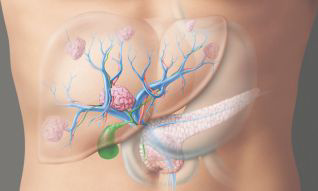Prof.Dr. Baer, a surgeon who specialises in abdominal surgery, explains the causes of liver cancer and why the disease is difficult to diagnose.

Interview with Prof.Dr. Baer
Prof. Dr. Baer, there have been many sagas and myths involving the liver since ancient times. Why is that?
Prof. Dr. Baer: The liver plays an important role in the myth of Prometheus. Prometheus formed mankind from clay. When the gods demanded that people offer sacrifices and worship them, Prometheus tried to outsmart Zeus – but he was unsuccessful. As punishment, Zeus took fire away from the people. But Prometheus managed to bring fire back to Earth. In the end, Zeus captured him and chained him to a rock where his liver was eaten by an eagle every day. However, the liver regenerated each night, because Prometheus was immortal. Prometheus begged for mercy until finally Hercules came and freed him from his suffering.
Is it true that the liver can regenerate itself?
Prof. Dr. Baer: It is true to a certain extent. During a hepatectomy up to 75 percent of the liver tissue can be removed. After a while, it is possible to determine that the remaining liver has grown larger. Messenger substances cause the liver cells to multiply.
What tasks does the liver perform in the body?
Prof. Dr. Baer: The liver acts as a blood filter between the intestine and the rest of the organism. It carries out a diverse range of important functions necessary for human metabolism. The liver itself produces important substances like blood clotting agents and cholesterol, maintains a balance of many substances like sugar, fat, hormones and vitamins, and helps to eliminate medication, metabolic products and toxins from the body. It is also the largest gland responsible for the production and release of bile, making it essential for the digestion of fat in the intestine.
What happens if a person’s liver function is impaired?
Prof. Dr. Baer: Impaired functioning of the liver tissue caused by tumours or inflammation has consequences of varying severity. The metabolism of sugar can be impeded, or the liver may not be able to produce enough proteins, which can lead to blood clotting disorders, or it might not effectively eliminate the bile salts and bile pigments. Left untreated, these impairments can lead to death.
What is a liver tumour and what is it caused by?
Prof. Dr. Baer: Like every organ, the liver can develop growths or tumours made from the organ’s own cells. They can be benign or malignant. The medical profession also makes a distinction between primary and secondary tumours. Primary liver tumours are formed from the liver’s own cells. With regard to the formation of the most common primary and malignant liver tumour, the liver cell carcinoma, we only know that it is caused by multiple factors: viruses such as hepatitis, hormones, chemicals, alcohol and other toxins.
Primary liver cancers are quite rare compared to secondary malignant liver tumours, otherwise known as liver metastases, which are found more frequently. These are stray cells from a malignant tumour that has developed in another organ, such as the large intestine, rectum or kidneys.
How do I know if I have a malignant liver tumour?
Prof. Dr. Baer: Patients with liver cancer often don’t display any characteristic symptoms. Changes in the liver tissue, particularly during the early stages, are often discovered by chance. That’s why patients with hepatitis have to periodically undergo ultrasound or CT examinations. Regular liver function tests are also very important. Generally speaking, liver tumours are usually only found by accident, because they do not cause any symptoms. So the chances of recovery also depend on the pre-existing condition. The rates of liver cancer are the same among women and men and our patients are usually aged between 50 and 70.
How are malignant tumours treated?
Prof. Dr. Baer: Hepatectomies, or partial removal of the liver, are necessary for many types of liver disease such as benign and malignant liver tumours, metastases, infestations of parasites like the fox tapeworm, or tumours in the gallbladder and pancreatic ducts. Different types of hepatectomy are carried out depending on the disease and the size, development and above all the location of the tumour. These days if primary malignant tumours or liver metastases are too large to be surgically removed, various techniques are used to reduce the size of the tumour, such as chemotherapy. The aim is to retain as much healthy liver tissue as possible and to shrink the tumour.
